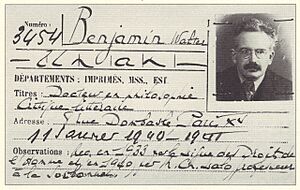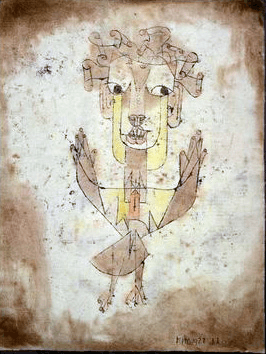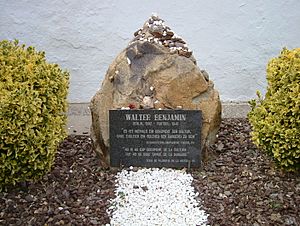Walter Benjamin facts for kids
Quick facts for kids
Walter Benjamin
|
|
|---|---|

Benjamin in 1928
|
|
| Born | 15 July 1892 |
| Died | 26 September 1940 (aged 48) |
| Education | University of Freiburg University of Berlin University of Bern |
| Era | 20th-century philosophy |
| Region | Western philosophy |
| School | Continental philosophy Western Marxism Marxist hermeneutics |
|
Main interests
|
Literary theory, aesthetics, philosophy of technology, epistemology, philosophy of language, philosophy of history |
|
Notable ideas
|
Auratic perception, aestheticization of politics, dialectical image, the flâneur |
Walter Bendix Schönflies Benjamin (born July 15, 1892 – died September 26, 1940) was a German Jewish philosopher, cultural critic, and essay writer.
He was a unique thinker who combined ideas from different areas like German idealism, Romanticism, Western Marxism, and Jewish mysticism. Benjamin made important contributions to art theory, literary criticism, and the study of history. He was connected to the Frankfurt School, a group of thinkers, and was good friends with people like the writer Bertolt Brecht and the scholar Gershom Scholem. He was also related to the political thinker Hannah Arendt.
Some of Benjamin's most famous writings include "The Work of Art in the Age of Mechanical Reproduction" (1935) and "Theses on the Philosophy of History" (1940). As a literary critic, he wrote about authors like Baudelaire, Goethe, and Kafka. He also translated parts of famous French books into German.
In 1940, when he was 48, Benjamin died in Portbou, a town on the border between France and Spain. He was trying to escape from the invading German army. Even though he wasn't very famous during his life, his work became well-known and respected many years after his death.
Life Story
Early Life and School
Walter Benjamin was born in Berlin, Germany, in 1892. His family was wealthy and Jewish. He had two younger siblings, Georg and Dora. His father, Emil Benjamin, was a banker and antiques dealer.
Walter's uncle, William Stern, was a famous child psychologist who created the idea of the intelligence quotient (IQ). Walter also had a cousin, Günther Anders, who was a philosopher.
In 1902, at age ten, Walter started at the Kaiser Friedrich School. Because he was often sick, his family sent him to a boarding school for two years. He returned to the Kaiser Friedrich School in 1907 and finished his studies there.
In 1912, at age 20, he went to the University of Freiburg. Later, he moved to the University of Berlin to study philosophy. There, he learned about Zionism, a movement for Jewish self-determination. He developed his own ideas about Judaism, seeing it as a way to support European culture. He believed Jews were important for spiritual and cultural progress.
Benjamin was a speaker in the German Youth Movement. He wrote essays about changing education and culture. He later studied at the University of Freiburg again, focusing on the lectures of Heinrich Rickert. He also traveled to France and Italy.
When World War I started in 1914, Benjamin tried to join the army but was rejected. He later pretended to be sick to avoid being drafted. This allowed him to continue his studies and translations.
In 1915, Benjamin moved to Munich and studied at the University of Munich. There, he met the poet Rainer Maria Rilke and Gershom Scholem, who became a close friend.
In 1917, Benjamin moved to the University of Bern. He met Ernst Bloch and Dora Sophie Pollak, whom he married. Their son, Stefan Rafael, was born in 1918. In 1919, Benjamin earned his PhD with a paper on art criticism in German Romanticism.
After his PhD, Benjamin struggled to support his family. He returned to Berlin and lived with his parents. In 1921, he published an essay called "Toward the Critique of Violence."
Important Friendships
Throughout his life, Benjamin was part of a group of smart thinkers in Berlin and Paris between the two World Wars. He knew many important people in philosophy, art, theater, and politics. He was not a leader or a celebrity, but he was often present at key intellectual events.
He was at a conference where Kurt Gödel first talked about his famous incompleteness theorem in mathematics. He took a class on the Ancient Mayans from Rainer Maria Rilke. He was friends with Bertolt Brecht, a very creative writer and director in Berlin's theater scene.
Philosopher Martin Buber was interested in Benjamin's work. Benjamin also spent time with Ernst Bloch while Bloch was writing his book Spirit of Utopia.
Benjamin's oldest friend, Gershom Scholem, became the person who managed Benjamin's writings after his death. Scholem helped bring back important Jewish mystical books into public knowledge.
Career and Exile
In 1923, Benjamin published a book about the French poet Charles Baudelaire. He met Theodor Adorno and became friends with Georg Lukács, whose ideas influenced him greatly. At this time, it became hard for Benjamin's father to support his family because of high inflation in Germany.
In 1924, Benjamin wrote a major work called The Origin of German Tragic Drama. He hoped this would help him become a university professor in Germany. He also met Asja Lācis, a Latvian actress, who became an important influence on his thinking.
In 1925, Benjamin decided not to submit his book to the university, fearing it would be rejected. He did not become a professor. He then worked on translating parts of Marcel Proust's famous novel In Search of Lost Time.
From 1926, he started writing for German newspapers, which helped him live in Paris for several months. In 1927, he began his biggest, unfinished project, Das Passagen-Werk, which was a study of 19th-century Parisian life.
In 1928, Benjamin and his wife Dora separated and later divorced. He published Einbahnstraße (One-Way Street), a collection of short writings.

In 1932, as Adolf Hitler was gaining power in Germany, Benjamin left Germany. He moved to the Spanish island of Ibiza and then to Nice, France. After the Reichstag fire in 1933, which showed the Nazis were taking full control and persecuting Jews, he moved to Paris.
He received money from the Institute for Social Research, a group of thinkers who later became known as the Frankfurt School. In Paris, he met other German artists and thinkers who were also refugees. He became friends with Hannah Arendt.
In 1936, an early version of his essay "The Work of Art in the Age of Mechanical Reproduction" was published in French. In this essay, he talked about how mass-produced art changes our experience of it. He argued that the "aura" or unique presence of an original artwork is lost when it is copied.
In 1938, the Nazi government took away German citizenship from Jews, making Benjamin stateless. He was arrested by the French government and held in a prison camp for three months.
Returning to Paris in January 1940, he wrote "Theses on the Philosophy of History". As the German army advanced into France, Benjamin fled Paris. In August, he got a visa to travel to the United States. He planned to go through Spain to neutral Portugal and then to the US.
On September 25, 1940, he reached the Spanish border town of Portbou. However, the Spanish government had cancelled all transit visas. The Spanish police told Benjamin's group that they would be sent back to France the next day. Benjamin died that night at his hotel. The official record states his death date as September 26, 1940. His brother Georg died in a concentration camp in 1942.
The rest of Benjamin's group was allowed to cross the border the next day and reached Lisbon safely. A friend, Hannah Arendt, later carried the manuscript of his "Theses" to another philosopher, Theodor Adorno. Another important manuscript Benjamin had with him disappeared after his death.
Key Ideas

Walter Benjamin had deep conversations with his friend Gershom Scholem, and also with Theodor Adorno and Bertolt Brecht. His work was shaped by these different influences: Brecht's ideas about Marxism, Adorno's critical thinking, and Scholem's knowledge of Jewish mysticism.
Some scholars also believe that Benjamin's wide range of interests came from his study of Western Esotericism, which includes ideas from different spiritual and mystical traditions beyond just Jewish Kabbalah.
"Theses on the Philosophy of History"
This essay is often seen as Benjamin's last complete work, finished in 1940. It was published after his death.
In this work, Benjamin talks about history, culture, and destruction. He mentions the Jewish belief that no one should try to predict when the Messiah will arrive. He explains that this doesn't mean Jews don't care about the future. Instead, it means that "every second of time was the strait gate through which the Messiah might enter," suggesting that hope and change can happen at any moment.
"The Work of Art in the Age of Mechanical Reproduction"
This is perhaps Benjamin's most famous essay. It explores how technology changes how we experience art. He introduces the idea of the "aura" of a work of art. The aura is the unique presence of an original artwork in its own time and place.
Benjamin argued that when art is mechanically reproduced (like photographs or copies), its aura starts to fade. This is because copies can go places the original never could, and they don't have the same unique history. He also discussed the "optical unconscious," which is our ability to see desires in visual things and to understand information through habit rather than deep attention.
The Origin of German Tragic Drama
This book, published in 1928, is a detailed study of German plays from the Baroque period (1600s). It also looks at the political and cultural situation in Germany during that time. Benjamin originally wrote this book to qualify as a university professor, but it was not accepted by the university. He published it as a book instead.
One Way Street
One Way Street (1928) is a collection of short writings, meditations, and observations. It's like a collage of different thoughts and ideas. The book includes aphorisms (short, clever sayings), jokes, dreams, descriptions of cities, and thoughts on child psychology.
Many of these pieces were first published in newspapers and magazines in a special section called the feuilleton. This section was at the bottom of every page, and its small space influenced the short, fragmented style of Benjamin's writing.
The Arcades Project
Passagenwerk (1927–1940) was Benjamin's final, unfinished book. It was a huge study of Parisian city life in the 19th century, especially focusing on the covered passages or arcades. These arcades allowed people to stroll and observe others, a practice called flânerie, even in bad weather.
In this work, Benjamin used his fragmented writing style to explore the rise of modern city culture in Europe. Some of his major published essays, like "The Work of Art in the Age of Mechanical Reproduction" and his writings on Baudelaire, were actually parts of this larger, unfinished project.
The Arcades Project brings together a massive collection of Benjamin's notes. It was first published in 1982 and is over a thousand pages long.
Writing Style
Benjamin's writing style is very unique. Some people have described it as having an "occult quality," meaning that parts of his writing might seem clear at one time and confusing at another.
His sentences often don't follow a simple, straight line of reasoning. It's as if each sentence tries to say everything at once. This "freeze-frame baroque" style can make his work challenging but also very insightful. The difficulties in his style are part of his philosophical goal. He wanted to use different texts and ideas to show hidden parts of the past that can't be understood in simple historical stories.
Benjamin's writings show him as a modernist thinker. He believed that simple logic couldn't explain all experiences, especially how art represents itself. In his essay "The Task of the Translator," he argued that when a text is translated, it changes. These changes can reveal new, hidden meanings in the original text, while making other parts less clear. This process of changing and revealing new connections is important for finding philosophical truth.
Remembering Walter Benjamin
There are plaques in Berlin and Paris where Walter Benjamin lived. In Berlin, a town square was named "Walter-Benjamin-Platz" in 2001.
There is also a memorial sculpture by artist Dani Karavan in Portbou, Spain, where Benjamin died. It was created to mark 50 years since his death.
Selected Works
Here are some of Walter Benjamin's important works:
- "On Language as Such and on the Language of Man" (1916)
- "The Task of the Translator" (1921)
- "Critique of Violence" (1921)
- The Origin of German Tragic Drama (1928)
- One Way Street (1928)
- "The Work of Art in the Age of Mechanical Reproduction" (1935)
- "Paris, Capital of the 19th Century" (1935)
- Berlin Childhood around 1900 (1938)
- "The Paris of the Second Empire in Baudelaire" (1938)
- "Theses on the Philosophy of History" (1940)
See also
 In Spanish: Walter Benjamin para niños
In Spanish: Walter Benjamin para niños
- Gertrud Kolmar
- Michael Heller
- List of people from Berlin
In Other Media
- Les Unwanted de Europa (2018 film about Benjamin's last days)
- 13, a ludodrama about Walter Benjamin, (2018 cinematic essay)
- The Passages of Walter Benjamin (2014 documentary)
- Who Killed Walter Benjamin? (2005 documentary)
- One Way Street: Fragments for Walter Benjamin (1992 documentary)




